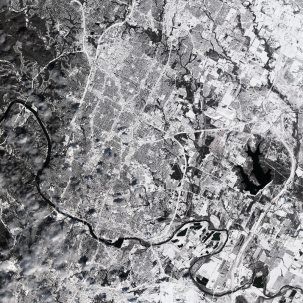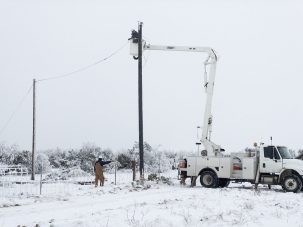Experts Weigh In on the Deep Freeze and Power Outages in Texas
Is a failure of wind power really behind the blackouts? How can we make sure this doesn’t happen again? Earth Institute scholars have answers to these questions and more.

This month, millions of Texans lost heat, electricity, and running water during a deadly cold snap that has lasted for days. In the midst of the danger and confusion, politicians and pundits immediately began pointing fingers and making spurious speculations as to the cause of the outages.
Earth Institute experts specializing in energy policy, grid resilience, and climate science have been weighing in to help to make sense of the complicated and dire circumstances. Here are some of the questions they are helping to tackle.
Did renewables really cause the outages?
Early on, factions promoting a fossil fuel agenda blamed Texas’ power outages on frozen wind turbines and the state’s reliance on renewable energy. However, Jason Bordoff, the founding director of the Columbia’s Center on Global Energy Policy, told CNN that no single energy source is to blame. “The extreme cold is causing the entire system to freeze up,” he said. “All sources of energy are underperforming in the extreme cold because they’re not designed to handle these unusual conditions.”
In an interview with Bloomberg on Tuesday, Bordoff pointed out that while it is true that wind output is down, “it’s also true that most of the lost electricity generation that’s forcing outages has come from gas and coal, because pipelines and valves are freezing coal piles are freezing.” In the latest episode of the Columbia Energy Exchange podcast, Bordoff and two other energy/electricity experts discuss what we do and do not yet know about what went wrong in Texas.
Wind turbines operate in Antarctica and other places much colder than Texas. On Mashable, Vijay Modi, a professor of mechanical engineering at Columbia University and an Earth Institute faculty member, said that making wind turbines resistant to cold weather “is not rocket science,” though it does make the turbines slightly more expensive. Modi added that as wind energy scales up, it would be wise to consider weatherizing more wind turbines.

The freezing temperatures are “affecting every piece of the supply chain. It’s not just wires; it’s not just pipelines; it’s not just power plants—it’s the whole thing,” Melissa Lott, a senior research scholar at the Center on Global Energy Policy, told Scientific American. “And if we want to prevent this from happening in the future, we’re going to have to think how we reinvest in the system to make it stronger, more resilient and more reliable.”
How can electric grids become more resilient?
Many experts have pointed out that Texas’ electricity grid is unique in that it is completely cut off from grids in other states. Speaking with Bloomberg, Bordoff noted that increasing its interconnections with other grids would enhance its resilience, so that it could draw power from other sources during emergencies such as this.
Romany Webb, a senior fellow at Columbia University’s Sabin Center for Climate Change Law, told the Washington Post that “for the most part, electric utilities and system operators are not at all prepared to deal with the more frequent and severe extreme weather events that climate change will bring.” She said that many utilities are investing in facilities that are ill-equipped to cope with climate change, and which will end up costing more money in the long run. However, as she told Bloomberg Law, she thinks the situation in Texas will prompt utilities to start thinking about and planning for climate change.
In 2019, scholars from the Sabin Center as well as Columbia University’s Lamont-Doherty Earth Observatory worked with the utility company Con Edison on a report highlighting the energy system’s vulnerabilities to climate change. The report also offered a variety of suggestions on how to address those challenges and increase the energy system’s resilience, which Con Edison is currently working to implement. (Read the full report here.) A more recent report about climate risk in the electricity sector — and how to build resilience — is available here.
How could the emergency response have been better?
Speaking with the Texas Tribune, Irwin Redlener, senior research scholar at Columbia University’s National Center for Disaster Preparedness, criticized the Texas government’s response to the emergencies. “From so many different perspectives, this is an example of a very poorly planned disaster response, and there’s all kinds of things that could have been better, including the communication issues,” he said. Read more here.
How does global warming contribute to cold snaps?
Writing for CNN, atmospheric scientist Adam Sobel from Lamont-Doherty Earth Observatory noted that icy disasters such as this are often cited as evidence against the reality of climate change. However, he writes, “The scientific consensus on human-induced global warming has never meant the permanent end of winter or of deadly cold snaps.”He goes on to explain that scientists are still debating how climate change affects the frequency and severity of cold snaps, but he lays out one way that it could make them more common. In a nutshell, warming in the Arctic weakens the jet stream, making it wavier. “If the jet bends all the way to the Gulf of Mexico, it brings Arctic air with it in what is also called the polar vortex,” he writes. Read the full explanation here.
Yutian Wu, an associate research professor at Lamont-Doherty Earth Observatory, helps to make sense of “polar vortex” events like this. In 2019, she used climate modeling to show that decreases in sea ice in the Barents and Kara seas could weaken the jet stream, allowing frigid air to break out of the Arctic.
Recent research co-authored by Earth Institute postdoctoral researcher Kai Kornhuber suggests that the mechanisms behind these sorts of cold snaps could also lead to more persistent heat waves in the summertime. Read more in National Geographic.
While scientists are still working out the relationships between climate change and cold snaps, one thing is very clear: by increasing the frequency and severity of heat waves, wildfires, hurricanes, and other extreme weather, climate change is going to continue to stress electric grids and cause human suffering. As Jason Bordoff told Bloomberg earlier this week, “it’s important to continue with an agenda that tries to move toward a low carbon energy system, and at the same time think about what we need to do to increase the reliability of the electricity system.”
